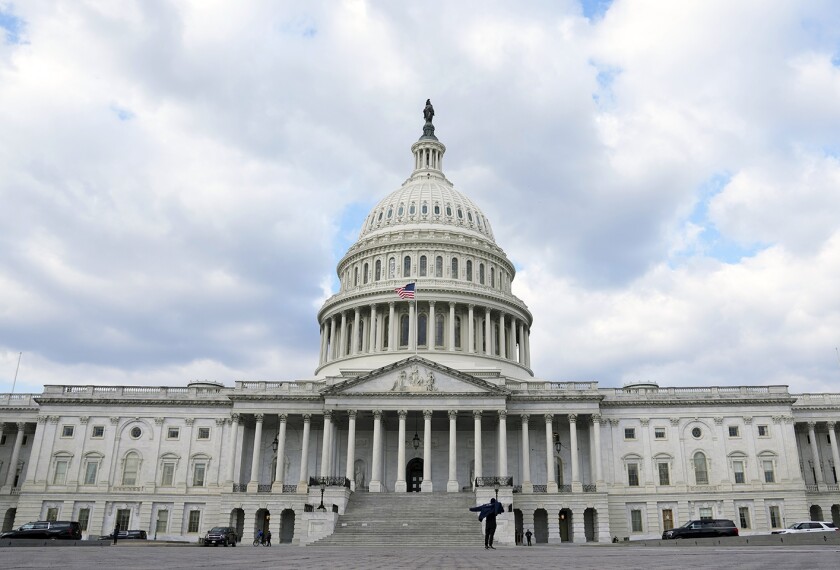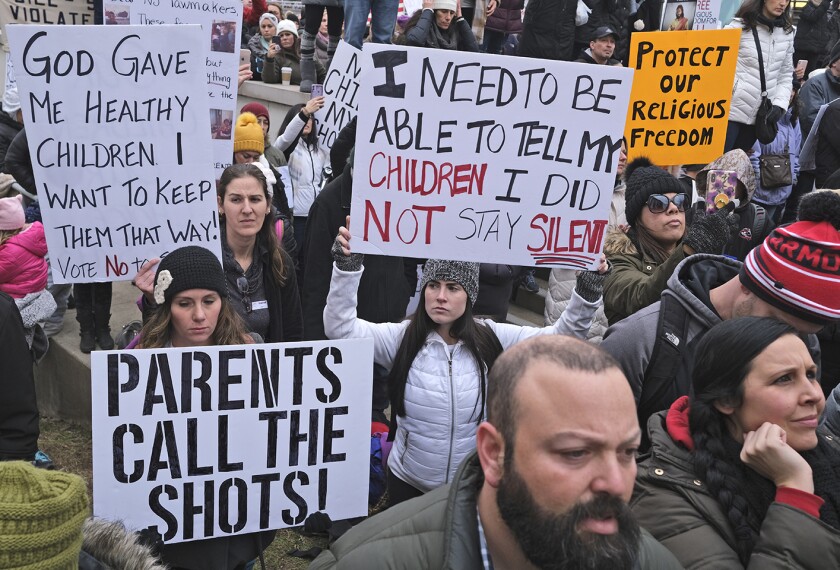NEW MEXICO
Johnson Calls For Vouchers, 10th Grade Graduation Exam
Gov. Gary E. Johnson of New Mexico doesn’t plan on being a lame duck in what will be the last legislative session of his second and final term.

In his recent State of the State Address, Gov. Johnson followed other governors’ calls for more state testing. He took some novel turns, however. For example, he proposed allowing students to proceed to college after just two years of high school—if they pass a test and get the nod from their parents.
“My education reform package focuses on student achievement,parental involvement, and system accountability,” Gov. Johnson said. “I am proposing common-sense ideas that are both practical and affordable.”
Earlier in January, Gov. Johnson proposed his fiscal 2003 budget, a “flat” budget which did not increase or decrease education spending levels. He said that his state budget proposal, at $3.87 billion, is the same amount of revenue the state expects to receive.
Not an Easy Sell
Gov. Johnson promised that his education proposals would not cost any additional funds. Indeed, he said that in the wake of the Sept. 11 terrorist attacks, he wanted to stimulate the economy through an income tax cut. He supports a $30 million income tax reduction in this session."Is this an easy sell, and will it happen this session? Probably not,” Gov. Johnson, a Republican, said. “Should it happen? Absolutely.”
Funding for his education package, which includes more testing for students and a pilot school choice program, would come from reallocating money already in the budget, he said.
Under Gov. Johnson’s plan, annual criterion-referenced assessments would replace the current norm-referenced exams given to all students in grades 3-8 in reading and mathematics.
Also, once a student has reached 10th grade, they could “test out” of the rest of high school, get a high school diploma, and go straight to college—with their parents’ consent. “I don’t think [the measure] takes into account what it takes for a student to have well-roundedness, maturity, and social skills,” said Veronica C. Garcia, the spokeswoman for the New Mexico School Boards Association. “I don’t think a 14- or 15-year-old usually has what it takes to be ready for a work or college environment.”
Tim Walsh, the governor’s special assistant for education, said he believes that if the plan passes, it might be a first in the nation.
“New Mexico has realized that not one size fits all in education,” Mr. Walsh said. “We are looking for options to give students a choice. We’ve always been very bold.”
He thinks students would like the flexibility. “Those individuals who don’t find high school a positive experience and a learning experience don’t have to stay,” Mr. Walsh added. “It’s a win-win situation. They can move on earlier to college or work. Another win is that the money that would have gone to educating that student then goes back into the pot to educate other students.”
Mr. Johnson also proposed a school choice program that would be phased in over five years to eventually reach all students statewide. Gov. Johnson has proposed a voucher program in the past. His previous versions—which have gone down to defeat in the legislature—would have been phased in over four years, and would not have started in a particular city. In those earlier versions, those eligible for the first round of vouchers would have been chosen on the basis of financial need. Poor families would have been chosen first.
Under the governor’s new plan, only students from poor families in Albuquerque would be eligible to apply for a voucher in the first year. The vouchers could be used at any public or private, including religious schools. Recipients would be chosen through a lottery system to get one of 2,900 vouchers, each worth $3,000.
New Education Post
Gov. Johnson also proposed creating the post of state education secretary to be the governor’s point person on school issues. The education secretary also would consult with the state board of education.
As part of his laundry list of proposed changes, he wants to streamline local education bureaucracies and called for consolidating smaller school districts while breaking up larger districts.
In the next three years, the districts would either merge or be broken down to create districts of the optimal size, which is between 5,000 and 8,500 students, Mr. Walsh said. The state’s current 89 districts would become 50 districts, under that formula.
In another measure, Gov. Johnson would amend a law that forces school districts to hire only union construction workers to build schools. He said this would result in more school construction.Without a union-enforced minimum wage requirement, the schools could get more work for less money, Mr. Walsh said.
Ms. Garcia of the school boards group said that most of Mr. Johnson’s package is consistent with what he’s proposed earlier in his tenure as governor.
“I don’t think any of these have a chance of passing this year,” she predicted.
The governor is more optimistic.
“Better schools mean our young people will be equipped to take their place in our rapidly changing world,” Gov. Johnson declared in his Jan. 15 speech. “Better schools mean more businesses will locate here. Better schools mean juvenile crime will go down because young people with better options make better choices.”
—Lisa Fine
ALASKA
Knowles Makes Pitch For Taxes, Aid for Schools
Gov. Tony Knowles stressed the need for increased spending on education, child safety, and health in his eighth and final State of the State Address.
But faced with a budget deficit this fiscal year that is $865 million and growing, he placed the most emphasis on balancing the budget and ensuring fiscal health through a balance of taxes and belt- tightening.
Nonetheless, as part of a three-year economic plan that he detailed in his Jan. 22 speech, the Democratic governor asked the legislature to approve a $33 million hike in education funding as part of his fiscal 2003 budget, which is $13 million more than the current fiscal year.
Mr. Knowles also backed a $17 million increase proposed by University of Alaska officials and a $13 million increase for the state’s Smart Start program.
Introduced four years ago, Smart Start provides basic health care to children and pregnant women, as well as child care and foster care.
The proposed new funds would boost resources for early-literacy programs and Head Start, and go toward battling teenage tobacco abuse, child abuse, suicide, and neglect.
“There can be an Alaska where our children can learn to the best of their abilities,” Gov. Knowles said. “I want to realize tomorrow’s returns by making wise investments today.”
The governor, whose earlier attempts to balance the budget were stymied by the GOP-run legislature, rolled out a three-year plan to phase in $400 million in new revenues annually for a total of $1.2 billion.
He proposed $350 million to come from reinstating an income tax, something Alaskans haven’t paid since 1980. Another $30 million would come from a 10-cent hike per alcoholic drink, which already has been introduced in the legislature and which he supports.
And the governor also hopes to garner $20 million in annual revenue from the state’s booming tourism industry by proposing a $30 per- passenger fee on cruise ships, which pay no corporate taxes to Alaska.
It’s also time for Alaskans to tighten their fiscal belts, the governor added. The state’s current $865 million deficit is expected to grow to $1.2 billion in the coming fiscal year. While the state has enough reserves to make up budget shortfalls until 2004, he emphasized addressing budget holes now to avoid damaging the economy in the long term.
“Each year in this balanced budget plan requires heavy lifting, and the first may well be the most difficult,” he said. “Yet the do-nothing approach is a blueprint for future economic disaster.”
—Rhea R. Borja
MAINE
King Declares Schools Free of Budget Cuts
With Maine facing fiscal uncertainty, Gov. Angus King is promising that the state’s schools won’t pay the price. “My budget maintains our commitment to education,” Mr. King, an Independent, said in his Jan. 22 State of the State Address, “and I am delighted we are united on this issue.”
To balance the state’s general- fund budget for fiscal 2003, the governor is recommending only minimal cuts from the department of education. None of his proposed recisions would have a direct impact on schools, he said.
In his speech, Mr. King sent a veiled warning for legislators to protect his highest education priority of his second term: a program to provide a laptop computer to all 7th graders. Some legislators have said that the new program, approved last year but not scheduled to begin until this fall, is a prime candidate for savings.
In speaking about economic development, Mr. King said: “We must maintain our commitment to education at all levels. Yes, including technology in the classroom.”
Mr. King did not mention another significant issue facing the legislature this session.
His administration will be proposing a funding formula for the state’s general aid for schools that would replace the current formula, which penalizes towns with high property values in favor of those without the ability to tax locally.
Department of education officials will be proposing an alternative designed to evaluate each district’s needs and pay them a share of state funds to meet those needs.
—David J. Hoff




